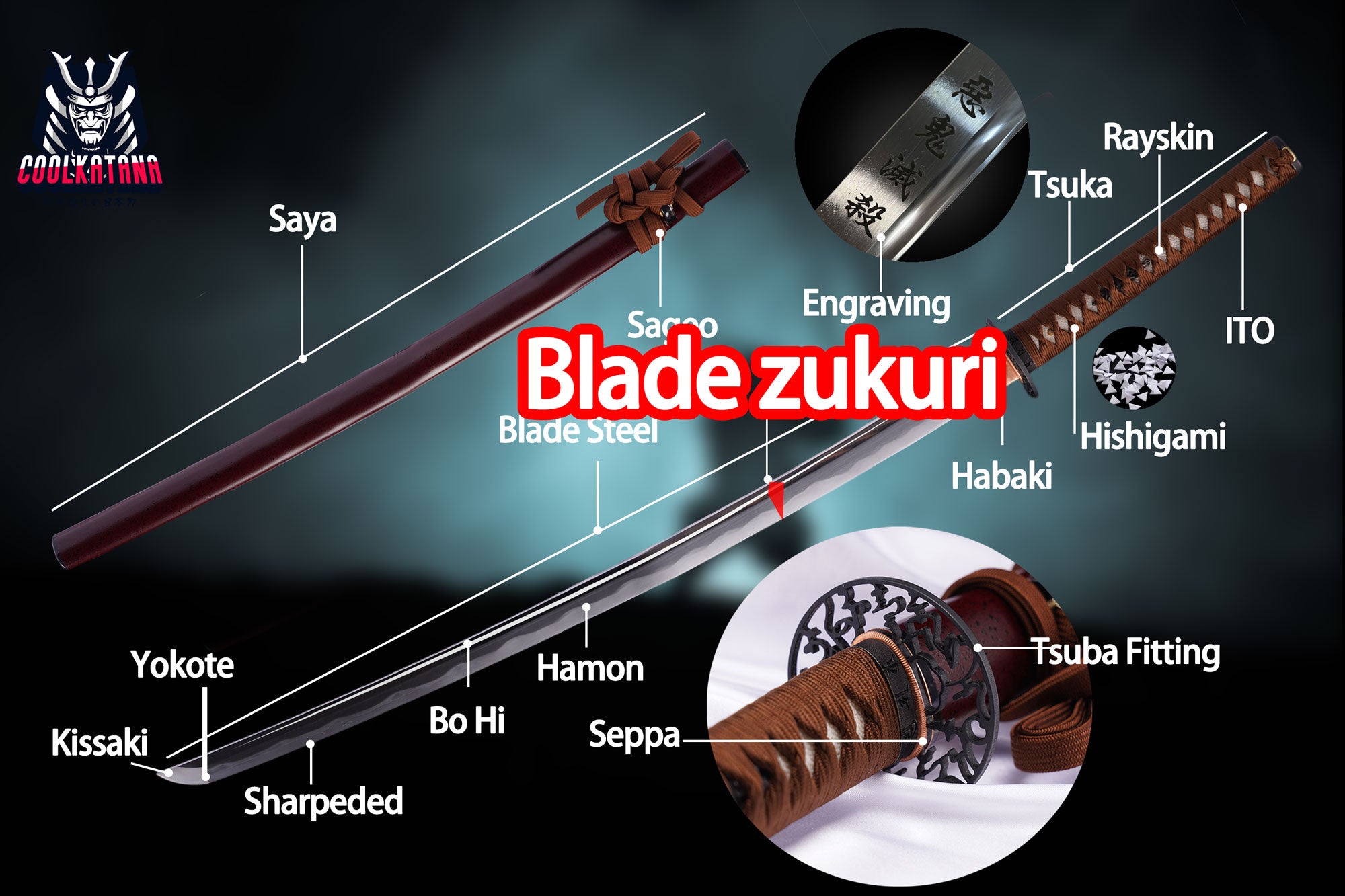Analysis of Samurai Sword Blade Zukuri Types and Characteristics

What is Zukuri Katana?
In traditional Japanese Katana design, Zukuri refers to the blade shape or construction method, which describes the overall appearance of the blade and the structure of the blade's edge and body. Different Zukuri types not only affect the sword's visual aesthetics but also have a significant impact on its cutting ability, performance, and handling. Common types of Blade Zukuri include Shinogi-Zukuri, Shobu-Zukuri, Hira-Zukuri, Kiriha-Zukuri, and Osoraku-Zukuri, each with unique advantages suited for various combat needs and usage scenarios.
In crafting a katana, Zukuri serves as a blend of the blade's design and the functionality, directly influencing the cutting power, balance, flexibility, and durability of the sword. Swordsmiths choose a specific Zukuri design based on the intended purpose of the sword, whether it's for armor-piercing, precision strikes, or efficient slashing. In addition, Zukuri shapes also contribute to the aesthetic appeal, reflecting the craftsmanship and cultural heritage of Japanese swordmaking.
1. Shinogi-Zukuri (次刃造)
Shinogi-Zukuri is the most classic and common Blade Zukuri design. The blade features a shinogi line (cutting line) running along the sides of the blade, giving it a dual-edge structure. The blade consists of the back (Mune), shinogi (cutting line), and edge (Ha), forming a distinct V-shape cross-section. This design strikes a perfect balance between cutting power and durability.
Shinogi-Zukuri Characteristics and Advantages:
- Outstanding Cutting Ability: The angle and shape of the edge make it ideal for clean, efficient cuts through targets.
- Balanced Design: The structure of the Shinogi-Zukuri provides a great balance, making the sword comfortable to wield for extended periods.
- Durability: The careful design of the edge and the shinogi ensures that the blade can withstand strong strikes without chipping.
Ideal Use:
- Perfect for traditional katana enthusiasts who appreciate both the performance and aesthetics.
- Commonly used in cutting, slashing, and hacking, ideal for collectors and martial artists.

2. Shobu-Zukuri (菖蒲造)
Shobu-Zukuri features a unique design where the blade’s edge extends significantly towards the back of the blade, and the curve is relatively shallow. This design is often seen in shorter and lighter swords, like short swords (such as Ko-Katana) or certain combat knives.
Shobu-Zukuri Characteristics and Advantages:
- High Penetration Power: The blade's relatively straight edge allows for quick, powerful thrusts, making it excellent for piercing through targets.
- Lightweight and Agile: The design is simplified, making the sword lighter and more flexible, ideal for rapid movements.
- Ideal for Close Combat: The design is excellent for fast, close-quarters strikes and counterattacks.
Ideal Use:
- Suitable for short swords or knives, such as Ninjato or other tactical knives.
- Well-suited for close-range combat, ambushes, and defensive situations.

3. Hira-Zukuri (平造)
Hira-Zukuri features a simple, straight design where both the back and edge of the blade are nearly flat, without any significant curve. This is one of the simplest and most basic blade designs, often used for utility swords or more straightforward battle knives.
Hira-Zukuri Characteristics and Advantages:
- Simplicity and Directness: The blade’s straight profile provides clear and efficient cutting performance, with a focus on utility.
- Robust and Durable: The lack of curves or intricate designs makes this type of blade highly durable and resistant to damage.
- Ideal for Chopping: This design is particularly effective in heavy slashing and chopping, making it ideal for utility tasks.
Ideal Use:
- Best for basic utility knives, simple katana, or tools requiring reliability and ease of maintenance.
- Great for tasks that require frequent hacking, cutting, and chopping.

4. Kiriha-Zukuri (切刃造)
Kiriha-Zukuri is a specialized design where the front of the blade gradually tapers into a sharp cutting angle. Unlike Shinogi-Zukuri, there’s no visible shinogi line, and the blade tends to form a more straight, linear shape with a fine cutting edge.
Kiriha-Zukuri Characteristics and Advantages:
- Sharp Cutting Edge: The tapering design creates a razor-sharp edge, perfect for precise cuts and delicate slicing.
- Increased Flexibility: The lighter build makes the sword more maneuverable, allowing for rapid response in battle.
- Ideal for Precision Strikes: The straight-edged blade excels at cutting soft and hard materials with accuracy.
Ideal Use:
- Suitable for precise cutting tasks, especially in situations where quick, clean cuts are essential.
- Ideal for collectors and practitioners seeking specialized blades for focused strikes.

5. Osoraku-Zukuri (恐怖造)
Osoraku-Zukuri is a rare and distinctive blade design where the blade’s edge has a deeper curve, and the tip is larger, offering greater cutting power. This design is often found in long swords or larger katana.
Osoraku-Zukuri Characteristics and Advantages:
- Greater Cutting Power: The deeper curve of the blade provides enhanced cutting strength, making it effective against heavy armor or defensive targets.
- Increased Destructive Power: This design helps generate more forceful cuts, delivering devastating blows to the enemy.
- Long Blade for Extended Reach: The longer blade design allows for better control in long-range combat, enhancing reach and stability.
Ideal Use:
- Best suited for large swords or long katana, especially in situations where extended reach and powerful cuts are necessary.
- Ideal for combat scenarios requiring high destruction power and strong cutting ability.

www.coolkatana.com
Conclusion:
Different Blade Zukuri designs significantly influence the functionality, cutting performance, and combat effectiveness of a katana. From the balanced Shinogi-Zukuri to the piercing Shobu-Zukuri, the durable Hira-Zukuri, the precise Kiriha-Zukuri, and the powerful Osoraku-Zukuri, each blade design offers distinct advantages for various martial needs. By choosing the right Zukuri type based on your preferences and the intended use, you can optimize your blade’s performance and experience its full potential.
Whether you are a traditional katana enthusiast, a tactical user, or a collector, understanding these Zukuri types will help you select the ideal blade for your needs, ensuring you get the most out of its performance and craftsmanship.

